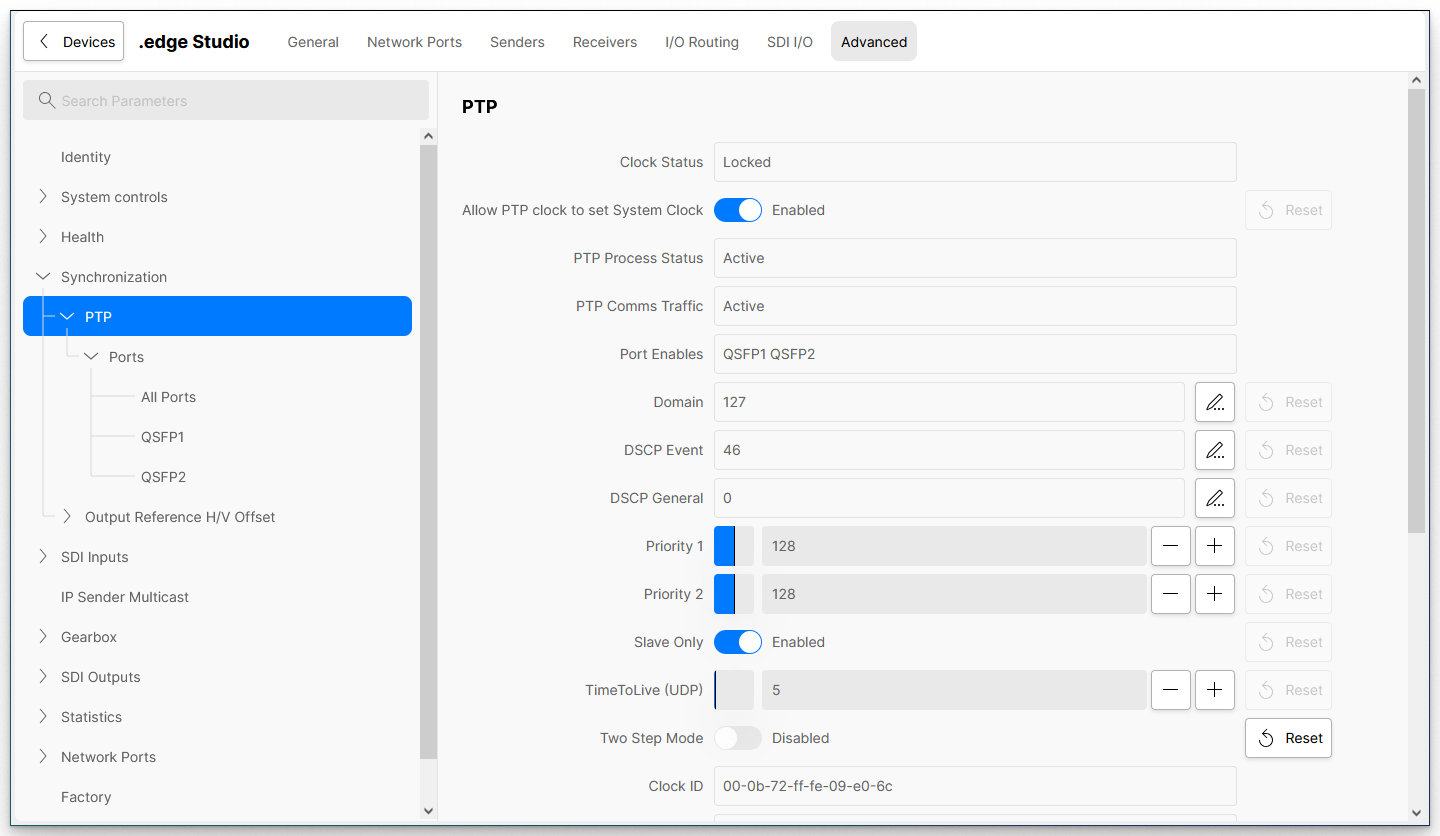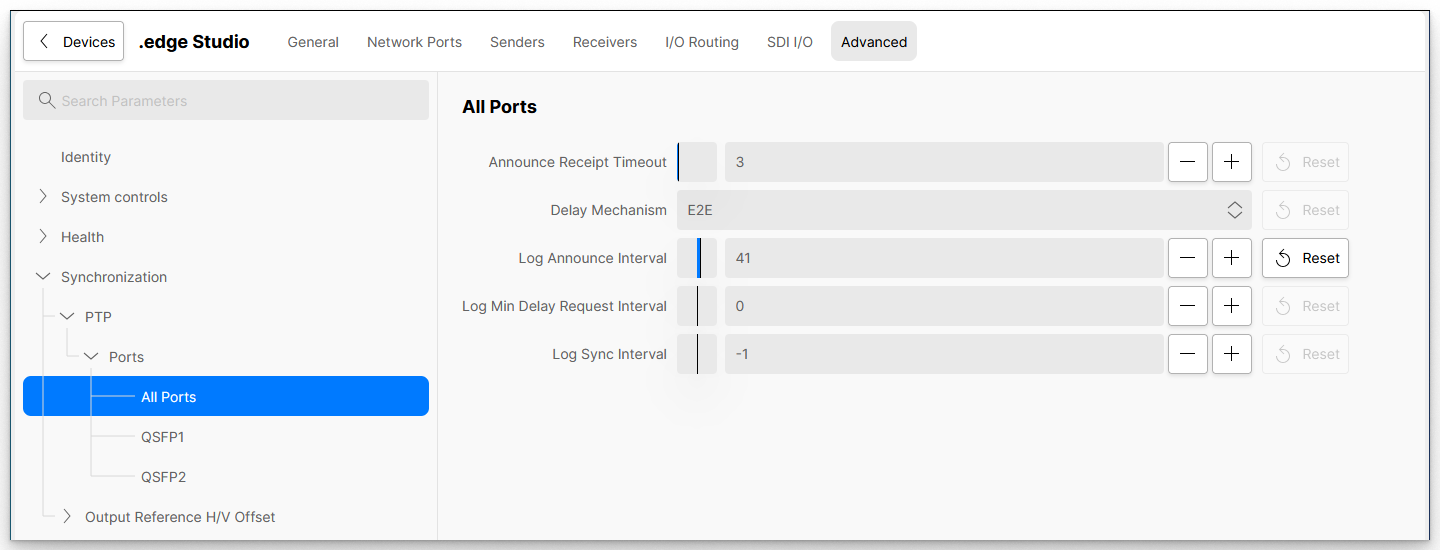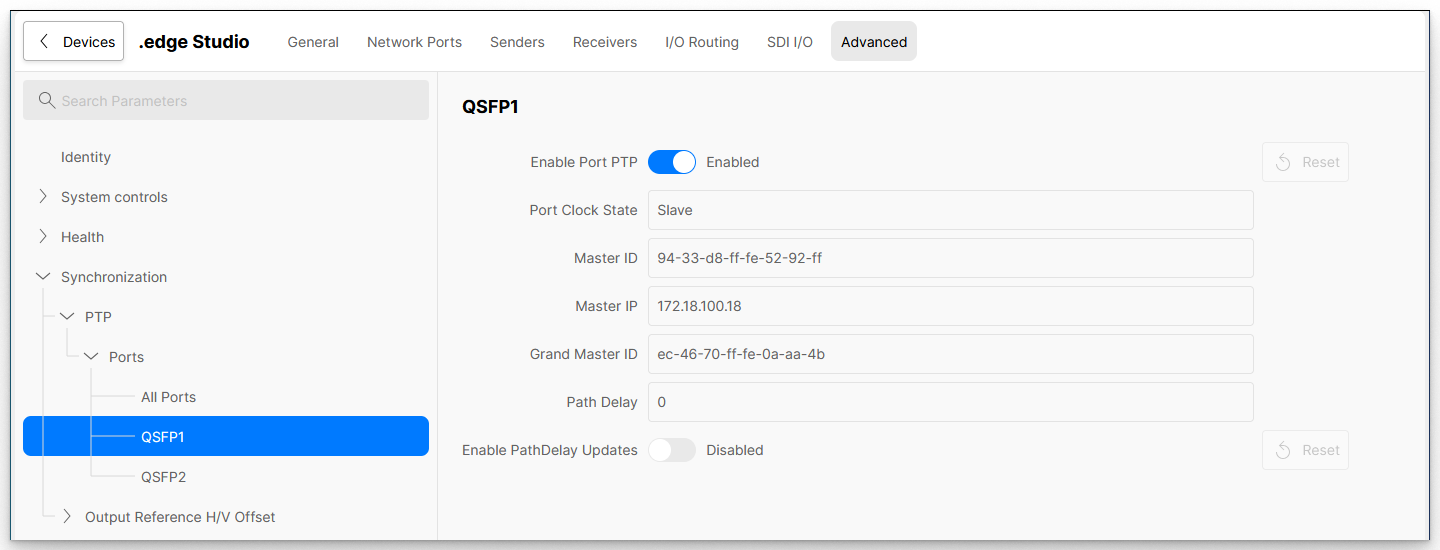.edge - PTP Configuration
The PTP parameters for a processing blade can be adjusted from the Synchronization → PTP sub-pages (in HOME's Advanced parameters). These options become relevant if the Mode Select option on the Synchronization page is set to PTP (as described earlier).
There is one main page with global parameters plus several sub-pages that address the ports.
The first option to check is Slave Only (as this defines the PTP mode):
- .edge can operate as a PTP slave only and so this option must always be enabled.
- In Slave Only mode, the processing blade looks for an incoming PTP signal from the media network (e.g. from an external grandmaster).
You can choose which port(s) are listening for PTP using the Enable Port PTP options. To configure redundancy, you must enable at least two ports.
The other parameters define the PTP priorities of the blade. How they should be configured depends on the network architecture and PTP profile in use. More information can be found in the Lawo IP Networking Guide.
In order for PTP to work correctly, and to avoid configuration mistakes, we strongly recommend using the same values for all PTP-capable devices, masters and slaves.
Global Parameters
Select the Synchronization → PTP sub-page to adjust the global parameters.

Synchronization → PTP
Clock Status
Shows the status of the PTP clock source (arriving from the network).
Allow PTP clock to set System Clock
When this option is enabled, the blade's system clock is set using Time of Day extracted from the incoming PTP signal.
This option can be used to ensure that the blade's system clock is set correctly, which is essential when using Lawo Flex credits for licensing.
PTP Process Status
Shows the status of the internal PTP processes within the blade. The normal state is Active.
PTP Comms Traffic
Shows if PTP data has been detected from the network. The normal state is Active.
Port Enables
Shows which port(s) are listening for PTP. You can add or remove port(s) using the Enable Port PTP options.
Domain
Defines the domain number. The recommended value for this field will vary depending on the PTP profile in use. Please refer to the Lawo IP Networking Guide.
DSCP
Defines the DSCP (differentiated services code point) or quality class. The default DSCP Event value is 46.
Priority 1 and Priority 2
These options set the PTP priorities of the processing blade.
PTP uses a master-slave approach in which all master-capable devices elect the best master, called the grandmaster, according to a common algorithm known as the Best Master Clock Algorithm (BMCA). The algorithm compares the following parameters in turn:
- Priority 1 - the lower the number, the higher the priority of the device.
- Clock Class
- Priority 2 - as for Priority 1.
- MAC Address
For example, if there is no Priority 1 available, then all devices on the network look at the Clock Class, then Priority 2 and finally the MAC Address.
Note that only the Priority 1 and Priority 2 values can be adjusted for .edge. The Clock Class cannot be adjusted but may be used by a third-party grandmaster if one is installed. The MAC Address (for the transmitting port) can be viewed in HOME's Network Ports tab.
In order to sync properly, the Priority values must be configured according to the system design. In particular, a Slave Only device will not sync properly unless its priority is lower than that of the desired grandmaster.
Slave Only
This option defines the PTP mode. For .edge, Slave Only must always be enabled.
TimeToLive
Defines the PTP Time To Live (TTL). The value determines how many "hops" the PTP clock streams may navigate. Each time a stream traverses a network switch, the TTL is reduced by one.
Two Step Mode
In PTP two-step, the time stamp message is sent separately after the sync message. This allows devices such as .edge to calculate the network delay of the route.
Clock ID, etc.
The following fields are for informational purposes and describe the PTP clock: Clock ID, Clock Accuracy, Clock Class and Clock Traceable.
The Clock Class is used by the BMCA algorithm (described above).
Clock Offset
When Enable Offset Updates is turned on, the Clock Offset shows the difference between the local clock (on the blade) and PTP signal being received.
All Port Parameters
The All Ports sub-page includes more global parameters that affect all media network ports: Announce Receipt Timeout, Delay Mechanism, Log Announce Interval, Log Min Delay Request Interval, Log Sync Interval.
The recommended values will vary depending on the PTP profile in use. Please refer to the Lawo IP Networking Guide.

Synchronization → PTP → All Ports
Individual Port Parameters
The remaining sub-pages adjust parameters for a specific media network port.

Synchronization → PTP → Ports → QSFP
Enable Port PTP
The Enable Port PTP options can be used to define which ports are listening for PTP from the media network.
The available ports depend on the FPGA mode of the blade. In each case, select a port (on the left) and then set the option using the on/off slider.
Port Clock State
Describes the clock state of the port. For .edge, the clock state should always show as Slave.
Master ID and Master IP
Describe the PTP master (on the network).
Path Delay
When Enable PathDelay Updates is turned on, the Path Delay shows the delay caused by the time taken for packets to travel between the PTP master and slave.